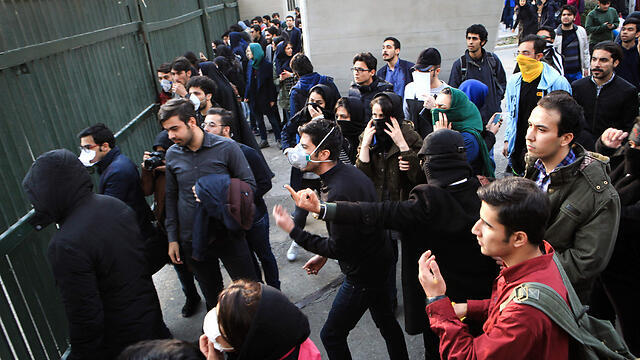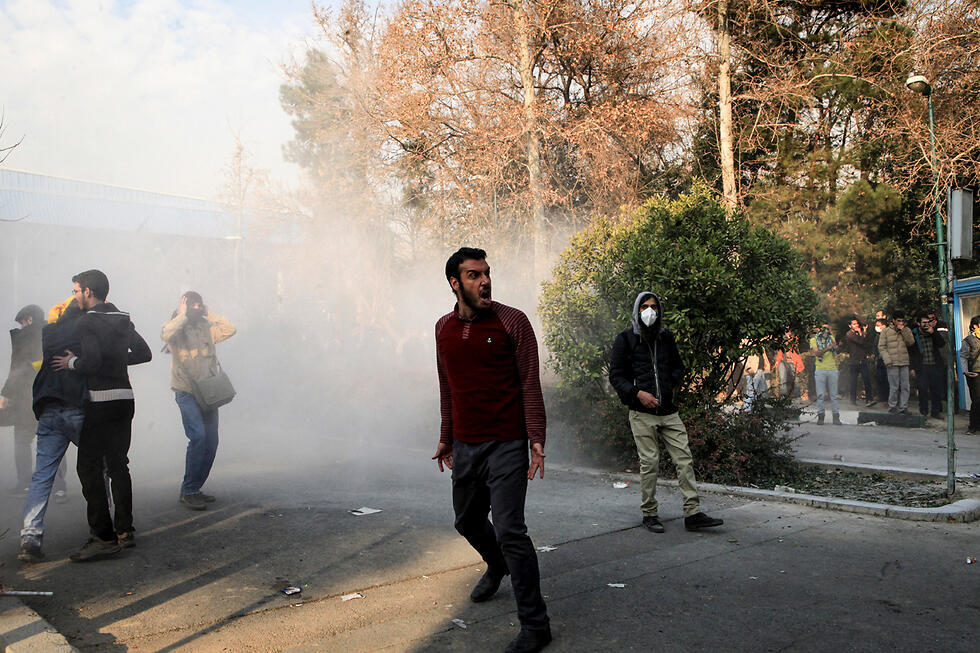Getting your Trinity Audio player ready...
The Iranians were filled with hope ahead of the implementation of the nuclear agreement .Their economy and society were on the verge of collapse, thanks to cheap oil prices and outrageous economic management. The agreement was supposed to help Iran join the world, open up its economy and lead to a celebration of growth. All that didn’t happen.
The Obama administration said from the very first moment that it wasn’t exempting Iran from its duty to distance itself from the terror networks and from the war in Syria. Some people mocked the administration, saying it would be impossible to stop the investors from flocking to the country. It turned out they were actually afraid of Iran, both because of its involvement in militant activities and because of the destructive governmental involvement in the economy.
2 View gallery


The slogans chanted in the protests of the past few days demonstrate that conventions have been shattered
(צילום: AFP)
The disappointment over the worsening economic situation is the background for the events that have been taking place in Iran in the past few days, but that’s a short-term look.
Iran is a country that has experienced a revolution in our generation. A revolution isn’t a normal governmental change. It’s not a quiet overthrow of a regime (like what happened in Eastern Europe, for example). A revolution isn’t a military putsch either. A revolution is a rare historic event, bloody and filled with changes, in which the entire society undergoes a dramatic transformation. Those who are at the top sink down, and those who are at the bottom sometimes find themselves in power.
The Iranian revolution took place in 1979, and blood was shed for years until it generated an Islamic theocracy with limited dimensions of an elected government. The death toll is incalculable. An Iranian friend once told me, “Anyone who has seen a revolution in his life will never want to see one again.”
The Islamic Republic is a revolutionary entity. Every Friday, its loyalists go to mosques and chant the traditional chants against the shah, Iran’s last king. “Death to America” and “death to Israel” are a revolutionary folklore in Iran.
In this radical world, exporting the revolution is a top duty: Just like it was an obligation for the communists in Moscow, it’s an obligation for the mullah regime in Tehran. That’s how the Iranians reached Iraq and Syria, and made it all the way to the shores of the Mediterranean Sea in Lebanon through Hezbollah.
2 View gallery


Protestors are completely undermining the entire Iranian political discourse
(צילום: AP)
What we have been seeing in the past few days in Iran is an event that is taking place within this revolutionary tradition. Iran is a much more open country than Israelis think, and people there are used to protests. They know their parents went out to protest and toppled the corrupt shah and his horrible secret police, SAVAK. They are going out now, continuing the revolutionary tradition. Only this time, unlike in 2009, the protestors are going beyond the slogans that are part of the norms of the Iranian state: They are chanting, “Death to Khamenei,” “Death to Hezbollah,” “We don’t want an Islamic republic.” They are shouting from the University of Tehran, “No to the conservatives, no to the reformists, the game is over.”
They are completely undermining the entire Iranian political discourse, which sprawls from President Hassan Rouhani to former President Mahmoud Ahmadinejad. It’s a discourse of religious clerics and their assistants, where there are different shades and a certain flexibility. Seculars, liberals, communists and others can’t take part in this discourse.
The slogan which should particularly serve as a wake-up call to the regime is “The nation sacrificed in the army, the army will sacrifice for the nation.” This slogan is taken from the revolution protests in 1979, and its purpose is to say to the soldiers: Rise up against the regime. At the time, the Iranian army refused to crush the uprising—and the shah was toppled.
The Islamic Republic survived all those who predicted it would collapse not because it is a withered, frozen body, but because there are flexibilities in the Iranian system, and because the public—having no other choice—has accepted that things can be said “through the system.” In other words, one can be a liberal or a patriot, but must use religious arguments.
The slogans chanted in the protests of the past few days demonstrate that these conventions have been shattered. The regime is still capable of crushing the protests relatively easily, and the numbers seem smaller than the mass protests of 2009, and it doesn’t look like the majority of the Iranian public is joining the protest. But a revolutionary environment could change very fast, and when the Iranians take to the streets they don’t usually go home quickly.
Nadav Eyal is Channel 10's chief international correspondent.

